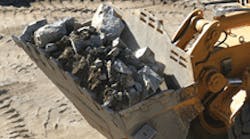A coal miner on the night shift was replacing tooth caps on a coal-loading-shovel bucket when one of the teeth shattered. Steel shards flew into the worker’s face and struck him in the eye.
The cap-replacement procedure involved removing the existing tooth cap from the hardened-steel tooth, welding on the underlying structure, and replacing the tooth cap. The worker used a 12-lb, steel-headed sledge hammer to pound the tooth cap back into place.
The bucket’s maintenance manual described the bucket teeth as “tough” and showed a sledge hammer hitting them. The teeth are composed of a high-carbon steel that resists the heavy-duty wear in mining applications. However, the alloy’s hardness comes at a price: brittleness that can lead to high-energy shattering on impact.
Neither the maintenance manual nor the bucket itself contained warnings about this significant hazard. Nor did they instruct workers to use softer hammer materials, such as rubber mallets, when reinstalling tooth caps. The tooth manufacturer has since updated its design so the caps can be replaced and secured without hammering.
The worker wore company-issued safety glasses certified to American National Standards Institute (ANSI) standard Z87.1- 1989. The standard covers safety glasses for machining, welding, cutting, chemical handling, and assembly in normal manufacturing environments, and OSHA requires that safety glasses protecting workers in industrial environments comply with the ANSI standard.
To ensure protection from flying debris, the standard says lenses must resist fracture or penetration by a needle attached to a 44-gm, 5-in.-long, 1-in.-diameter wooden cylinder dropped from 127 cm. The complete lens-and-frame assembly mounted on a headform must withstand impact from a 500-gm metal cylinder with a conical tip dropped from 130 cm.
Investigators in this case confirmed that new glasses identical to those the worker was wearing passed the ANSI Z87.1-1989 requirements. However, they estimated the glasses would have failed if 25 to 50% more energy had been applied.
It is reasonably foreseeable that the energy of the flying shards that injured the worker exceeded that of the test probes. In fact, warnings supplied by the safety-glasses manufacturer indicate the glasses’ protection is compromised when they are pitted or scratched by flying debris or other hazards and that additional protection must be used where there is severe exposure to flying particles.
However, these and other warnings are only printed on the thin plastic sleeve the glasses come in. It is reasonably foreseeable that a worker would discard the sleeve before reading the warnings or even receive the glasses without the warning label. Warnings of this type should be printed or attached to the glasses.
Edited by Jessica Shapiro
This month’s safety violation comes from the files of Lanny Berke, a registered professional engineer and Certified Safety Professional involved in forensic engineering since 1972. Got a safety violation to share? Send your images and explanations to [email protected].
